1970s
Alfred Schmitz’s Casket with Internal Body Supports
A casket designed for upright burial. From Schmitz's 1975 patent:In the past, caskets and vaults have been buried in a substantially horizontal position. Burial space, especially in urban areas, is becoming more scarce. A solution to such a problem may be found in burying caskets in a substantially vertical position. With such burial techniques, the amount of space required for each burial is substantially reduced.
While previously known caskets could be buried vertically, rather than horizontally, it should be realized that their use might be found distasteful by those who have been close to the party to be buried. An objection to the use of prior caskets may be found in the fact that in prior caskets generally there is nothing to support the body against shifting toward the foot end of the casket when buried in an upright position. Thus, if a conventional casket is tipped upright the body would slump to the foot end of the casket.
Related post: Upright Burial

Posted By: Alex - Thu Oct 21, 2021 -
Comments (0)
Category: Death, Inventions, Patents, 1970s
American Tentative Society
The officers of the American Tentative Society insisted that, despite the odd name, the society wasn't a joke. Its purpose, they explained, was to promote the idea that scientific knowledge should always be regarded as tentative — subject to growth, revision, and change.The three founders of the society were science journalists Alton Blakeslee, Rennie Taylor, and Pat McGrady. They came up with the concept in the mid-1960s, but it remained nothing more than a crazy idea until 1974, when Taylor died. In his will he bequeathed $300,000 to making the society a reality. This left the other two stuck with the problem of how to spend the money. So they solicited ideas from the public.
As far as I can tell, they ended up using some of the money to give awards to scientists (such as Stephen Jay Gould) whom they viewed as embracing the tentative nature of scientific knowledge. The rest of it was eventually given to the Council for the Advancement of Science Writing to endow a fellowship awarded annually to students accepted for enrollment in graduate-level programs in science writing.
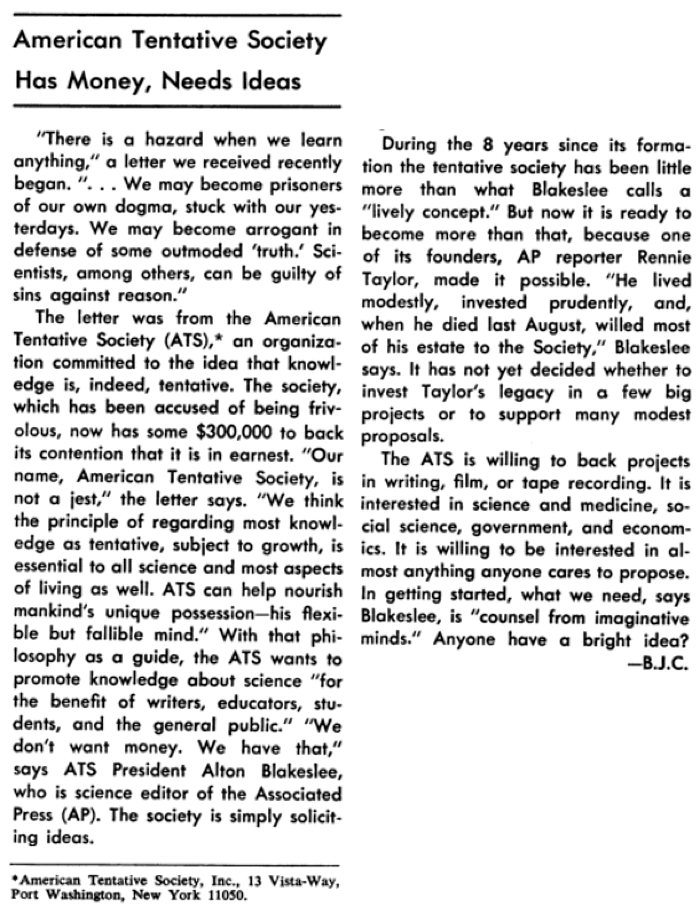
Posted By: Alex - Tue Oct 19, 2021 -
Comments (1)
Category: Clubs, Fraternities and Other Self-selecting Organizations, Science, 1970s
Booth Babes vs. the Teamsters
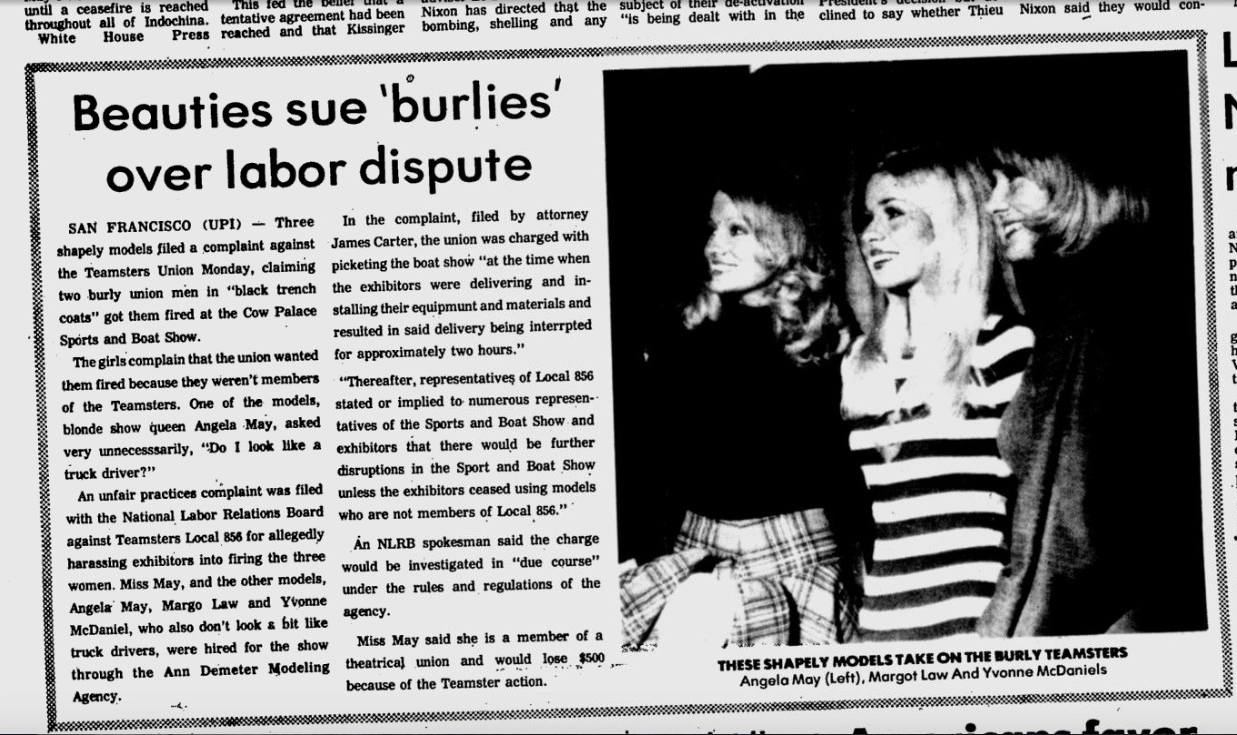
Source.
Posted By: Paul - Tue Oct 19, 2021 -
Comments (2)
Category: Beauty, Ugliness and Other Aesthetic Issues, Business, Conventions, Tradesmen, Manual Laborers, and Skilled Workers, 1970s
Richard Nixon, Cottage Cheese, and Ketchup
Richard Nixon's favorite snack was reportedly cottage cheese topped with ketchup.A 1960 article in the LA Times treated this as noncontroversial personal information about the then-presidential candidate, noting that he had acquired a taste for this unusual delicacy from his Quaker grandmother.

Los Angeles Times - Mar 14, 1960
However, by the 1970s Nixon's team was downplaying his fondness for this snack. Helen Smith, the first lady's press secretary, dismissed it as overblown rumor.

Casper Star Tribune - June 5, 1973
Similarly, White House chef Henry Haller, in his book The White House Family Cookbook, denied he had ever seen Nixon eat such a concoction: "If the President ever doused his cottage cheese with catsup, I never saw him, and doubt he ever did."
I suspect the truth is that Nixon enjoyed this snack when he was younger, but didn't continue eating it when he was President. Regardless, the combination of cottage cheese and ketchup was definitely associated with Nixon in the public mind, and it inspired one odd work of art.
In 1973, on the eve of Nixon's second inauguration, the sculptor Carl Andre dumped 500 pounds of cottage cheese on the floor of the Max Protetch gallery in Washington, DC. He then topped this with 10 gallons of ketchup. He called the work 'American Decay'. However, it smelled so bad that it all had to be removed the next day.
More info: Interview Magazine

'American Decay'. Image source: bonhams
Posted By: Alex - Mon Oct 18, 2021 -
Comments (0)
Category: Art, Food, Politics, 1970s
Gee Geronimo the Snail
I'm not aware of many famous snails. Gee Geronimo, as far as I know, may be the only one. Back in the 1970s, the Guinness Book of Records declared him to be the world's biggest snail. His owner was Christopher Hudson. Gee Geronimo died in 1976.
Christopher Hudson with Gee Geronimo
source: 1978 Guinness Book of Records

Connellsville Daily Courier - Nov 27, 1976
Hudson was apparently more in love with his snails than he was with his wife.

Honolulu Advertiser - Feb 4, 1977
Posted By: Alex - Wed Sep 15, 2021 -
Comments (4)
Category: Animals, World Records, Marriage, 1970s
Grant’s Negative Incentives
As Grants department store lurched towards bankruptcy in the mid 1970s, its senior management instituted a program to motivate store managers to meet sales goals — with a particular emphasis on trying to get more customers to sign up for credit accounts. This program involved using "negative incentives," which was a euphemism for publicly humiliating managers whose employees didn't meet sales goals. Details from Leadership Theories and Case Studies by Garry Wade McGiboney:Stories of the company's focus on outrageously negative motivation seemed exaggerated, but court documents from bankruptcy hearings confirmed the stories. At the time, W.T. Grant's bankruptcy was the second largest in business history...
The negative motivation led to store managers threatening and intimidating their store employees to the point that they were giving credit to almost every customer without any effort to discern if the customer had the means to pay the credit card bill. This negative-based practice spiraled out of control and eventually put the company in debt of over $200 million in unsecured credit.

According to newspaper reports from the time, one store manager was forced to walk around a hotel lobby dressed only in a diaper. Another was thrown into a blow-up swimming pool full of ice.
And sometimes these humiliations were forced upon store managers even if their employees met sales goals, because the company executives "believed it would somehow motivate employees if they saw the boss suffer some indignities." So really, whatever the managers did, they were going to be humiliated.
Posted By: Alex - Sat Sep 11, 2021 -
Comments (1)
Category: Business, 1970s
The Death of Pierre Beaumard
1979: To help cure his shyness around women, Pierre Beaumard's therapist had him lie sandwiched between two mattresses. This was meant to simulate the womb. Four people then walked on top of the mattresses to "stamp out his complexes". Beaumard died of suffocation.I'm skeptical about whether this story is true. For some reason it makes my BS spidey sense tingle. It was definitely reported in papers as legitimate news, but it's been known to happen that reporters will hear an urban legend or joke and then (knowingly or not) put it out on the wire services as a true story. I'm suspicious that's what happened here. I'd believe it more if I could find an original French source, which I can't.
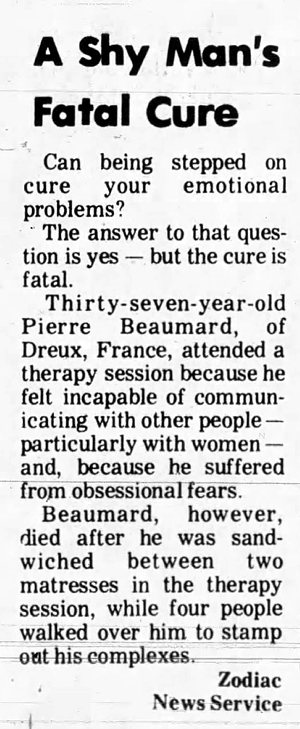
The Santa Clarita Signal - May 27, 1979

The Ottawa Citizen - May 17, 1979
Posted By: Alex - Sun Sep 05, 2021 -
Comments (2)
Category: Death, Psychology, 1970s
What happens when a fly lands on your food
1970 ad for the UK Health Education Council. The text is credited to Charles Saatchi, who was then a young advertising executive (and is now a wealthy art collector).More info: The Guardian

Posted By: Alex - Tue Aug 31, 2021 -
Comments (1)
Category: Food, Insects and Spiders, Advertising, 1970s
Melvin Belli Drinks Glenfiddich
The ad below, in which trial lawyer Melvin Belli endorsed Glenfiddich scotch, ran in the New York Times and New York Magazine in early 1970. Taken at face value, it doesn't seem like a particularly noteworthy ad. However, it occupies a curious place in legal history.Before the 1970s, it was illegal for lawyers to advertise their services. So when Belli appeared in this ad, the California State Bar decided he had run afoul of this law — even though he hadn't directly advertised his services. It suspended his license for a year. The California Supreme Court later lowered this to a 30-day suspension — but it didn't dismiss the punishment entirely.
Some high-placed judges felt sympathetic to Belli, which added fuel to the movement to end the 'no advertising' law for lawyers, and by 1977, the Supreme Court had struck down the ban on advertising, saying that it violated the First Amendment. That's why ads for legal services now appear all over the place. Compared to the ads one sees nowadays, Belli's scotch endorsement really seems like no big deal at all.
More info: Belli v. State Bar, "Remember when lawyers couldn't advertise?"
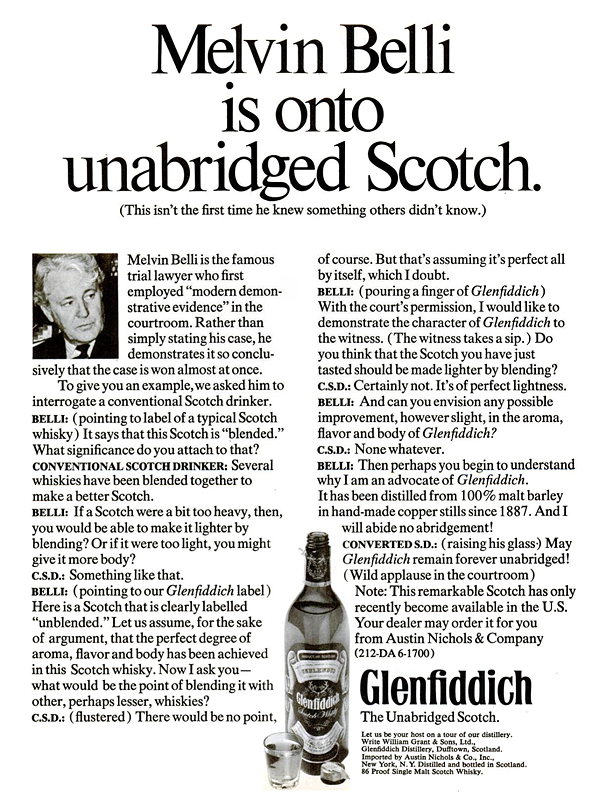
New York Magazine - Mar 2, 1970
Posted By: Alex - Mon Aug 16, 2021 -
Comments (5)
Category: Law, Advertising, 1970s
“I thought the Kama Sutra was an Indian restaurant”
Smirnoff ran this ad in the 70s but reportedly pulled it after a few months when its market researchers surveyed customers and discovered that "60 per cent of them thought that the Kama Sutra was indeed an Indian restaurant."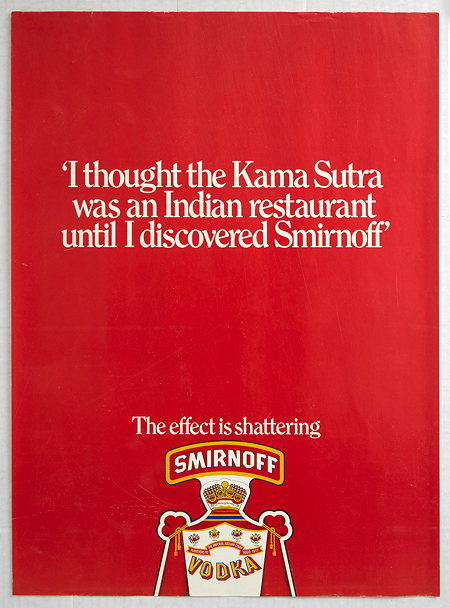
image source: codex
But according to Delia Chiaro in The Language of Jokes, the ad lived on in popular memory, inspiring a genre of "Smirnoff jokes".
I thought innuendo was an Italian suppository until I discovered Smirnoff.
I thought cirrhosis was a type of cloud until I discovered Smirnoff.
However it was not long before the graffitists began to abandon the formula, first by substituting the word Smirnoff with other items:
I thought Nausea was a novel by Jean-Paul Sartre until I discovered Scrumpy.
Soon, the caption began to move more radically away from the matrix, as more items were changed. In the next example there is no allusion to drink whatsoever:
I used to think I was an atheist until I discovered I was God.
Although Smirnoff jokes are now practically obsolete, the I thought A was B until I discovered C formula has now frozen into the English language as a semi-idiom. Today we can find graffiti (or indeed hear asides) such as:
I used to talk in cliches but now I avoid them like the plague
in which the original matrix is barely recognizable.
Below is another Smirnoff ad from the same series.
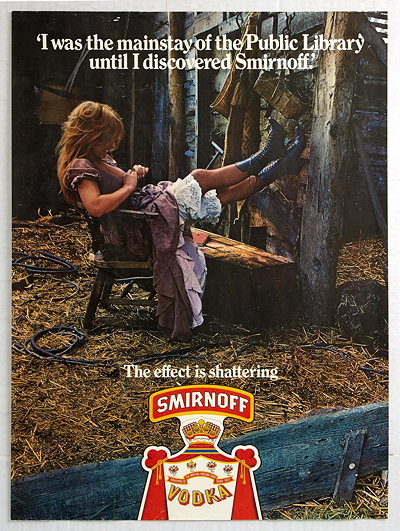
Posted By: Alex - Wed Aug 11, 2021 -
Comments (5)
Category: Inebriation and Intoxicants, Advertising, 1970s, Jokes

| Who We Are |
|---|
| Alex Boese Alex is the creator and curator of the Museum of Hoaxes. He's also the author of various weird, non-fiction, science-themed books such as Elephants on Acid and Psychedelic Apes. Paul Di Filippo Paul has been paid to put weird ideas into fictional form for over thirty years, in his career as a noted science fiction writer. He has recently begun blogging on many curious topics with three fellow writers at The Inferior 4+1. Contact Us |




